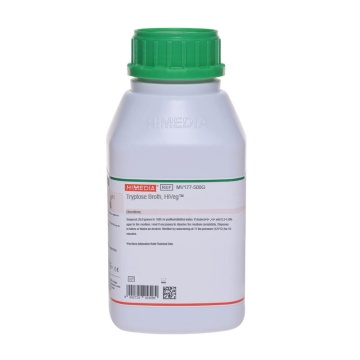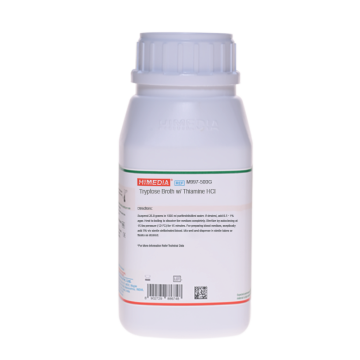 Your enquiry has been submitted
Your enquiry has been submitted
Tryptose Broth
Intended Use
Recommended for the cultivation primarily of Brucella species.
Composition
**Formula adjusted, standardized to suit performance parameters
| Ingredients | g / L |
|---|---|
| Tryptose | 20.000 |
| Glucose (Dextrose) | 1.000 |
| Sodium chloride | 5.000 |
Final pH ( at 25°C) 7.3±0.2
Directions
Suspend 26.0 grams in 1000 ml purified/distilled water. If desired, add 0.5-1.0% agar to the medium. Heat if necessary to dissolve the medium completely. Dispense in tubes or flasks as desired. Sterilize by autoclaving at 15 lbs pressure (121°C) for 15 minutes.
Principle And Interpretation
Huddleson used Tryptose media for the isolation of Brucella species from man (1). Tryptose containing media, rather than the conventionally used meat infusion media have been used for the enumeration and isolation of Brucella species (2,3). Tryptose Broth is also recommended by APHA (4) and FDA (5). This medium can be used as general purpose media for cultivation of wide variety of organisms. It can also be supplemented with defibrinated blood (sheep, horse) to prepare blood containing medium for the isolation of fastidious organisms like Brucella. Tryptose Broth can be supplemented with 0.1% agar for the cultivation of anaerobes. Dextrose is the source of energy. Tryptose serves as nitrogen source while sodium chloride maintains osmotic equilibrium.
Type of specimen
Clinical sample : body fluids ; Food samples
Specimen Collection and Handling
For clinical samples follow appropriate techniques for handling specimens as per established guidelines (6,7).
For food samples, follow appropriate techniques for sample collection and processing as per guidelines (4).
After use, contaminated materials must be sterilized by autoclaving before discarding.
Warning and Precautions
In Vitro diagnostic use. For professional use only. Read the label before opening the container. Wear protective gloves/protective clothing/eye protection/face protection. Follow good microbiological lab practices while handling specimens and culture. Standard precautions as per established guidelines should be followed while handling clinical specimens. Safety guidelines may be referred in individual safety data sheets.
Limitations
- All presumptive anaerobic organisms must be identified by confirmatory test.
Performance and Evaluation
Performance of the medium is expected when used as per the direction on the label within the expiry period when stored at recommended temperature.
Quality Control
Appearance Cream to yellow homogeneous free flowing powder
Colour and Clarity of prepared medium Basal Medium : Yellow coloured, clear solution. With addition of 5% v/v sterile defibrinated blood, cherry red coloured, opaque solution forms in tubes.
Reaction Reaction of 2.6% w/v aqueous solution at 25°C. pH : 7.3±0.2
pH 7.10-7.50
Cultural Response
Cultural characteristics observed after an incubation at 35-37°C for 48-72 hours with added 5% v/v sterile defibrinated blood in presence of 10% Carbon dioxide (CO2).
| Organism | Inoculum (CFU) | Growth |
|---|---|---|
| Brucella melitensis ATCC 4309 | 50-100 | good-luxuriant |
| Brucella suis ATCC 4314 | 50-100 | good-luxuriant |
| Streptococcus pneumoniae ATCC 6303 | 50-100 | good-luxuriant |
| Streptococcus pyogenes ATCC 19615 | 50-100 | good-luxuriant |
Storage and Shelf Life
Store below 10-30°C in a tightly closed container and the prepared medium at 15-30°C. Use before expiry date on the label. On opening, product should be properly stored dry, after tightly capping the bottle in order to prevent lump formation due to the hygroscopic nature of the product. Improper storage of the product may lead to lump formation. Store in dry ventilated area protected from extremes of temperature and sources of ignition Seal the container tightly after use. Product performance is best if used within stated expiry period.
Disposal
User must ensure safe disposal by autoclaving and/or incineration of used or unusable preparations of this product. Follow established laboratory procedures in disposing of infectious materials and material that comes into contact with clinical sample must be decontaminated and disposed of in accordance with current laboratory techniques (6,7).
Reference
- Huddleson I. F., 1943, Brucellosis in man and animals, rev., Ed., The Commonwealth Fund, New York, N.Y.
- Huddleson I. F., 1939, Brucellosis in Man and Animals, Oxford University Press, Oxford, England.
- Ruiz Castañeda M., 1947, Proc. Soc. Exp. Biol. Med., 64:114.
- Salfinger Y., and Tortorello M.L., 2015, Compendium of Methods for the Microbiological Examination of Foods, 5th Ed., American Public Health Association, Washington, D.C.
- U.S. Food and Drug Administration, 1995, Bacteriological Analytical Manual, 8th Ed., AOAC International, Gaithersburg, Md.
- Isenberg, H.D. Clinical Microbiology Procedures Handbook 2nd Edition.
- Jorgensen, J.H., Pfaller, M.A., Carroll, K.C., Funke, G., Landry, M.L., Richter, S.S and Warnock., D.W.(2015) Manual of Clinical Microbiology, 11th Edition. Vol. 1.
| Product Name | Tryptose Broth |
|---|---|
| SKU | M177 |
| Product Type | Regular |
| Physical Form | Powder |
| Origin | Animal |
| Packaging type | HDPE |
| References | 1. Huddleson I. F., 1943, Brucellosis in man and animals, rev., Ed., The Commonwealth Fund, New York, N.Y. 2.Ruiz Castañeda M., 1947, Proc. Soc. Exp. Biol. Med., 64:114. 3.Huddleson I. F., 1939, Brucellosis in Man and Animals, Oxford University Press, Oxford, England. 4.Downes F. P. and Ito K., (Ed.), 2001, Compendium of Methods for the Microbiological Examination of Foods. 4th Ed.American Public Health Association, Washington, D.C. 5.U.S. Food and Drug Administration, 1995, Bacteriological Analytical Manual, 8th Ed., AOAC International, Gaithersburg,Md. |
| Customized Product Available | No |









